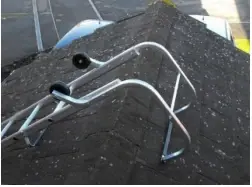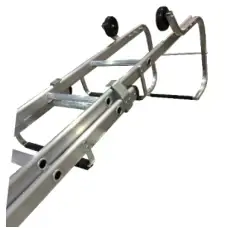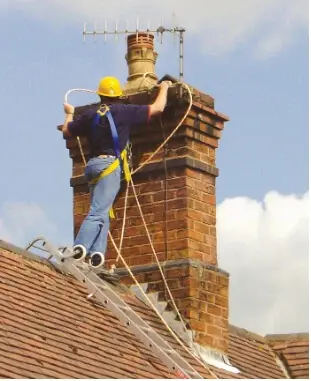Safely accessing a roof ladder.
Take extra care getting on and off the roof ladder. Make sure you have a firm grip on the leaning ladder before attempting to get on or off the roof ladder. (this is the reason to have 3 rungs of the leaning ladder higher than the roof ladder.)
Go up and down the roof ladder by crawling and gripping the rungs with your hands NOT the stiles (sides). Make sure you have a good foothold on the rungs. Take care not to stand on the roof surface.
Maintain 3 points of contact and when coming down do it by crawling backwards on your front.
NEVER FACE DOWN WHEN COMING DOWN!!
NEVER REACH OUT FROM BETWEEN THE STILES (SIDES) AS THIS MAY CAUSE THE LADDER TO BECOME UNSTABLE
Keep your hands free when climbing up and down the ladder, use a suitable tool belt and DO NOT overload the ladder with tools or materials etc.
Be aware of any overhead power-lines - many roof ladders are made of aluminium a good conductor of electricity. Any contact with a power line could have a shocking end!!
Take account of the weather conditions, high winds, ice, strong sun and fog all bring extra risk to the job that may mean it has to be delayed for safety reasons.
Wear Personal Protective Equipment
Appropriate trousers. Working on roofs means protecting legs from cuts, grazes and splinters, so shorts are not recommended.
Protective footwear. Steel toecaps (or equivalent) are needed to protect against dropped objects. Midsole protection is needed to prevent puncture or penetration by nails and other sharp materials.
Safety helmets. There are two reasons to wear safety helmets when working on roofs. The first is to protect against anything that may fall off the roof, when climbing up or down, or when on the ground. The second is protection in case of a fall.
Safety glasses should always be worn in situations where material is likely to fly into the eyes. This includes all cases where cutting or sawing is taking place.
Knee pads should also be considered, to protect the knees from strain and damage, due to compression and wear on the joint.
Consider summer and winter working conditions
In summer, sunscreen should be used to protect against sunburn and skin damage, that in the long term could lead to skin cancer.
In winter, warm clothing, that gives freedom of movement should be worn – like jackets and fleeces, hats and gloves. Being cold increases the likelihood of falls, as it numbs sensation, causing people to lose their grip, stumble or trip.
For a working at height safety awareness course with a RoSPA certificate click here.




